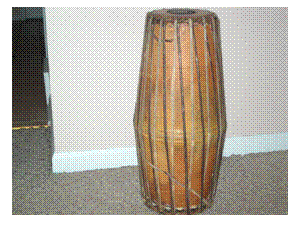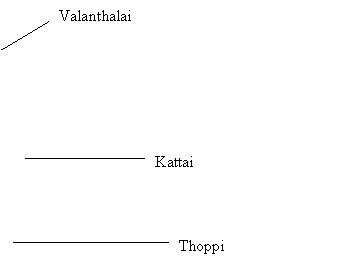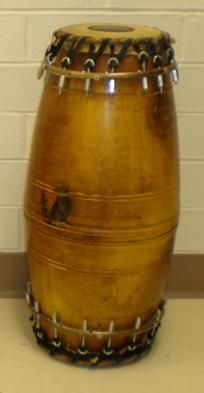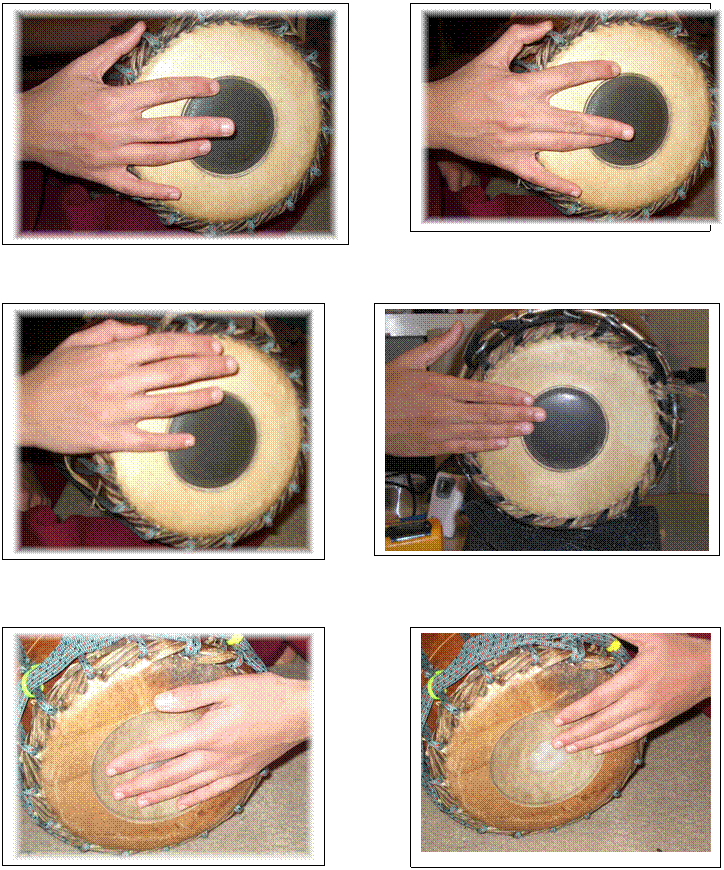

[ Lay Language Paper Index | Press Room ]
Rohan Krishnamurthy, rohan@rohanrhythm.com
Kalamazoo College,
Kalamazoo, MI 49006
Ian K. Hempe & James P. Cottingham
Coe College,
Cedar Rapids, IA 52402
Popular version of paper 4aMU12, “Acoustics of the mridangam: Study of a new design of a South Indian drum”
Presented 11:00 a.m. Friday Morning, November 30, 2007
154th ASA Meeting, New Orleans, LA
 |
 |
| The major parts in a traditionally-constructed mridangam. | |
The mridangam is the primary musical drum of South India and has a history of nearly 2000 years. The drum is comprised of three primary parts: the tonal head, bass head, and central jackwood shell to which the two heads are traditionally fastened by leather straps. Amongst the many auxiliary parts to the instrument are the temporary wheat paste loading on the bass head used to lower the pitch and dampen the bass end, and the central black loading on the tonal head, which is composed of an iron oxide and starch mixture that allows for the production of definite pitches. This pitched element gives the drum its characteristic melodic and percussive character. The instrument is traditionally played sitting barefoot on the floor with the drum horizontally positioned on the artist’s calf.
 Mridangam with the new mounting system |
 The author demonstrates his new mridangam in the traditional posture befor the former President of India, Dr. Abdul Kalam, at his office on New Delhi, July 2007. |
Nobel prize winning physicist C.V. Raman, most famous for the optical effect named after him, published an early study on the mridangam in the 1930s that recognized that the first five harmonics of the mridangam resulted from the nine normal modes of vibration. Since then, very few experimental studies have been conducted on the acoustics of the mridangam.
Over the past three decades, the globalization of Indian music has resulted in a large number of international performances and a substantial number of performers residing outside of India. In turn, instrument maintenance has become ever more challenging and is of the utmost concern to practitioners all over the globe. Pitch maintenance and overall deterioration of the heads are the two most prominent problems faced by practitioners. These problems are largely exacerbated by the colder climates many players face outside of India, particularly in North America and Europe. Conventional methods of instrument maintenance require the specialized skills of a mridangam artisan, which is obviously unfeasible for practitioners outside of India, and to a large extent, outside of certain South Indian cities where mridangam artisans are readily accessible.
In response to this, a new design of the ancient mridangam was proposed by the author that combines the traditional strapping with a nut-and-bolt system of mounting (For more information, see “A New and Practical Design for the Mridangam,” Percussive Notes. Vol. 44, No. 4, 34-36 (2006)). This design offers several advantages over the traditional design including independent tuning of the drumheads, easy head replacement, and a greater pitch range. The present study investigated the acoustical properties of the mridangam with both mounting systems to scientifically evaluate the impact of the new mounting system on the tonality of the instrument.
Measurements of modes and mode frequencies were made by mechanically exciting the heads with a mechanical vibrator and laser vibrometer setup. Drumhead vibration and sound spectra from standard strokes on both heads were also recorded. Based on the sound spectra and response curves, the new mounting system seems to maintain the important spectral features of the traditional design, including the nearly harmonic relationship of the first five modes. This is of practical interest since the new mounting system does not change the basic tonality of the instrument.
Using a similar analysis, the following conclusions were drawn from measurements of other practical performance variables: 1. Altering the pitch of the tonal head by an interval of a fifth with the new mounting system did not change the basic acoustical properties of the drumhead and demonstrated that the acoustic properties of the head are independent of the tightening process. 2. Wetting the bass head caused a decrease in bass head frequencies and an overall damping effect, but did not change the other spectral features of the bass or tonal heads. 3. Insertion of an iron oxide powder into the tonal head did not detectably change the acoustic properties of the tonal head. 4. Comparisons of the traditional wheat paste and silicone rubber on the bass head revealed that the two dampening fixtures generate nearly identical spectra.
In sum, this study indicates that the modern reengineering of the ancient mridangam has maintained the unique tonal qualities of the instrument and is thus a feasible substitute for the traditional design.

The six standard mridangam strokes employed in this study. The first four are played on the tonal head and the last two on the bass head.